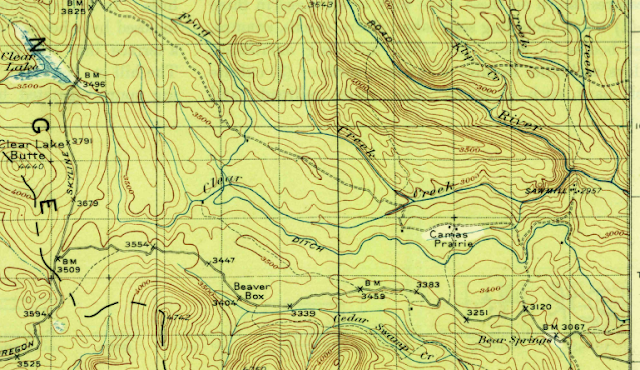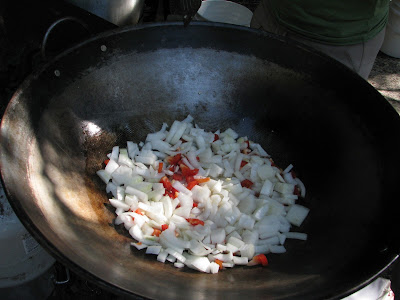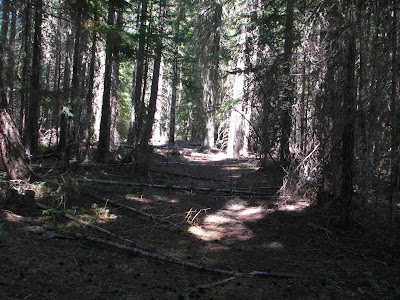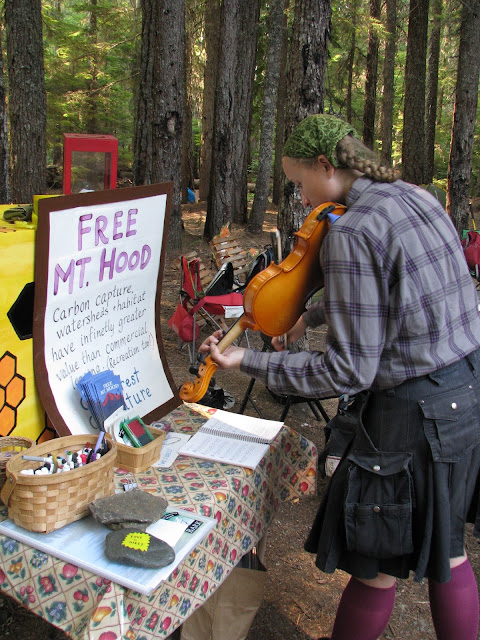Base Camp is a public campout in the beautiful Mt. Hood National Forest, during which campers will support Bark's work by contributing time to gather critical field information on proposed logging projects, pollinator species, and the effects of road building in the surrounding woods. We've also invited speakers and presenters from around Mt. Hood to participate and share their work so that as we spend time together in the forest we can build connections and find intersections between our work and that of other environmental, social, and other place-based movements.
I have had the privilege of volunteering with BARK for the past few months. My life has been rich with change, love and new experiences, and forever without regret. Time stands still for no one. I'd like to tell you about these recent experiences, and a little bit about BARK the organization and what they're doing for the Mt. Hood region.
What brought me to BARK? Well, I'll tell you. I feel that our national forest management has been going in the wrong direction for decades. I have witnessed the splendor of many ancient valleys that are met with the sharp edge of a clearcut. The big trees? They are already gone. This is not exaggeration or hyperbole. See for yourself on any Google satellite, pick any Northwest national forest and check it out. Checkerboard, miles of waste and roads. These are no mere woodlots; no these were the finest forests the world has ever seen. Thick ancient trunks of furrowed cedar strain to reach the heavens, their roots twisted into the rich soil. A crystal creek bubbles nearby, forever in unison with this ancient giant. Many others line the rocky banks, in between the moss and the basalt. Over 50% of Oregon's native forests have already been lost and logged - most within the past 30 years.
When I first came to Oregon from those goldenrod prairies "back east", I had no experience in the shaggy land of Sasquatch. Wet behind the ears, I took off into the woods in my old red truck, rusted through the floor from Midwest salt. I volunteered with the Forest Service. They taught me how to fix trails, how to track history, how to live like a Twenties Forest Guard. I swear one of those guys was a ghost, fresh from the trail in 1928. He didn't belong here in any rate.
In those days, the Forest Service was kind to the small band of trail volunteers. The old timers taught us how to use a chainsaw and crosscut and not kill ourselves. The recreation department "Mother Bear" held a potluck in her house each Christmas season, and she showered us with Forest Service gear: gloves, tools, Smokey Bear doodads. It was very heartwarming, and also nice to be appreciated for all those hot summer miles of trail we were fixing for free.
At the same time, I began to notice the clearcuts. Arbitrarily they appeared, wiping out historical sites and splendid natural features alike. In their place stood dark forests, sinister in their closeness where all trees are exactly the same like sweet corn. The Forest Service seemed hell-bent on destroying their own history, and it didn't make any sense to me. What about all of the grandfathers that once worked this forest, the pride of their lost youth? All of that dedication and hard work for conservation went out the window with the mechanized clearcut.
A shakeup in the Forest Service! The old guard suddenly retires, all of the friendly faces and wisdom are gone. Murmurs of a new boss, and people are unhappy.
And that is the last I've heard from the Forest Service. Though, just before the shakeup, I received a nice "certificate of appreciation" suitable for framing.
Already at odds with the current Forest Service agenda, I was happy to move on and let our relationship slip into the past. The past, ironically, is where the best work of the early Forest Service lies. The current management of the agency would do well to study conservation strategies pioneered in the 1920s here in the Northwest and still very valid today. Simply: save some trees for the next generation. Leave wilderness alone, let God sort it out.
The election of 2016 really shook things up, didn't it? No matter what side of the fence you are on, there is no doubt that the crazy results were a real kicker. You know, I really love those wild areas, and it became immediately clear that these most vulnerable places were instantly threatened. I marched with the women of Portland in solidarity in the rain, the first time I've ever attended such an event. I stood in the rain with the flu, the tears running down my cheeks. All of these smiling mothers and daughters, a hundred thousand or more marching in the rain for peace and motherhood. It was something to behold and something I will never forget. I will stand in the rain for Mothers any day of the year.
"What can I do?", many of us thought, with the ideals of democracy crumbling at our footsteps.
In April, I began volunteering with BARK, helping with maps and planning this very same Base Camp. With my intricate knowledge of Mt. Hood National Forest, I hoped to help in some meaningful way.
In 1993 two friends, attorney Greg Dyson and musician John "Lenny" Rancher, began a call to action after witnessing vast clear-cuts and old-growth logging while exploring Mt. Hood National Forest. They began to hike each timber sale, noting the markings in the forest and calling attention to discrepancies between action on the ground and agency documents. Soon they discovered that others shared their passion for protecting Mt. Hood, and began training them to "groundtruth" as well. Eventually, Greg brought together a diverse array of dedicated professionals and passionate activists to form a working board of directors and Bark was born. Bark was officially founded in 1999 and has since trained hundreds of volunteers about the basics of forest policy, brought thousands to Mt. Hood National Forest, and saved tens of thousands of acres of forest from logging and roadbuilding.
What I discovered was a scrappy bunch of very dedicated people, mostly volunteers and led by a very small and hardworking staff. There are lots of meetings, so many meetings and ways for volunteers to help and feel appreciated. And Base Camp, planning for an event I hadn't attended before; Base Camp would soon be on the horizon!
Why Base Camp? Currently, the Forest Service is proposing a massive, 12,000 acre logging operation within the Mt. Hood National Forest, the largest of such proposals in decades. Volunteers are needed to map and categorize these places before it is too late. Maybe it's already too late for these forests, but we have to do something, don't we?
Crystal Clear "Restoration Project", each numbered square will result in heavy logging operations
1927 USGS map of the same area, showing a roadless wilderness flanking the nearby Barlow Road
On to the camp.
"Where is everyone?", I ask at the empty Bark office. I have been hired to move gear out to the forest, and my Bus is empty as a warehouse.
"Oh! You just missed them! 5 minutes ago they took off!".
A lovely and solitary drive down US26, the old Volkswagen straining over the passes, but it's early enough to not piss anyone off and the traffic is light. Before I know it, I'm pulling off the pavement into the dusty parking lot of Base Camp 2017. A few volunteers are already scurrying about like ants and setting up gear - tents, a camp kitchen, awnings and tables.
Before too long, night falls and it's time for an early bed. The stars smear off at an angle, an arm of the Milky Way juts out into space and you gasp for air for a second.
CLANG! The least resonant circle of metal ever crafted rings out a dull clunk through the camp: breakfast is ready.
Bark volunteer Mia fries up something delicious
We soon fall into a slow and comfortable daily routine: breakfast in a circle, announcements and introductions followed by the day's mission.
Base Camp hosts Michael and Audie explain the day's agenda
Michael talks to volunteers about the Crystal Clear Timber Sale
We are broken up into groups of 3, and eventually we are out in the woods.
For many, this is their first time walking through the wilderness.
Bark volunteer Rachel measures the diameter of an ancient tree in the logging unit
filling out a "Ground Truthing" form, detailing many aspects of the timber sale
historic irrigation waterway abutting the timber sale
After a couple days of struggling through these tangled forests, it becomes clear that they are hiding an important secret: tucked away behind the strips of 1950s clearcuts are substantial ancients forests. Acres of them, miles of 400 year old western hemlock lie just beyond the monoculture and decaying old roads. The Forest Service is trying very hard to log these old trees, forests older than the US Constitution. Can you believe that? In this enlightened age, a time of wisdom and of science, that a group of men would propose something so foolish?
But that is what they intend to do.
8/25/17
Dear Interested Public,
The Mt. Hood National Forest has recently released a Preliminary Assessment for the Crystal Clear Restoration Project located on the Barlow and Hood River Ranger Districts. We are now seeking comments from those that may be interested in or affected by this project.
This project has been in development since 2016 when presentations were made to collaborative groups on the Barlow and Hood River Ranger Districts. Following these discussions, on November 4, 2016, a pre-scoping letter was mailed to 160 individuals and groups providing general project information, potential needs and location. This initial outreach was to provide the public an opportunity to visit the planning area before there was snow on the ground since the formal scoping process was planned to occur during the winter of 2017. In addition to this pre-scoping letter, a public field trip was scheduled on November 17, 2016, which was coordinated with both Districts' collaborative groups: the Wasco County Forest Collaborative Group; and the Hood River Stew Crew. As a result, input and recommendations were received for consideration to improve the proposed action. On March 1, 201 7, a scoping letter providing information and seeking public comment was also mailed to approximately 160 individuals and groups.
The purpose of the Crystal Clear Restoration Project is to provide forest products where there is an opportunity to restore resiliency to forested areas and reduce the risk of uncharacteristic wildfire behavior. The need for action in this project area, consistent with Forest Plan direction, is to promote the overall sustainability of vegetative systems. Sustainability would be enhanced by increasing the resiliency of the area to withstand severe, uncharacteristic fires, or widespread occurrence of mortality from insects and disease.
In order to restore resilience and reduce the risk of uncharacteristic wildfire within the planning area, the proposed action would include thinning unmanaged stands and plantations of varying ages on approximately 12,725 acres. All thinning activities proposed in this project would apply variable density thinning, which allows for flexible local density levels and site characteristics to achieve the overall project objectives. Variable density thinning also allows for an emphasis to be placed on leaving vigorous trees of all sizes. Proposed treatment types would occur in either dry or moist mix conifer forest types and would place a greater emphasis in areas that were identified as needed for strategic fuel treatment in the Mt. Hood Strategic Fuel Treatment Plan.
In addition to the purpose and need for the project and the highlighted treatments to restore resilience to the landscape as described above, all of the proposed activities and effects analysis are available in the Preliminary Assessment, which is available on the Forest's website (http://www.fs.usda.gov/goto/mthood/projects). The Forest's website also contains maps showing the proposed activities. The Preliminary Assessment discloses the impacts and benefits of the proposed action and shows that they implement the goals of the Forest Plan, as well as the associated planning documents applicable to the project area.
We are now providing a 30-day public comment period for the Preliminary Assessment. Comments must be submitted within 30 days from the legal notification of the opportunity to comment in The Oregonian. The publication date of the legal notice is the exclusive means for calculating the time to submit a comment. Specific written comments should be within the scope of the proposed action, have a direct relationship to the proposed action, and must include supporting reasons for the Responsible Official to consider.
Comments will be accepted via mail and email. For mail, you may send your comments to the address below. You may also hand-deliver your comments to the mailing address during normal business hours from 7:45 am to 4:30 pm Monday through Friday, excluding federal holidays.
Crystal Clear Restoration Project
Attn: Casey Gatz, IDT Leader
Barlow Ranger District
780 NE Court St
Dufur, OR 97021
working with Russ, a seasoned BARK employee and a hellava nice guy
Along a Barlow Road-era wagon road, restored as a hiking trail
Ancient Douglas Fir along the old road
A faint wagon road, former route to Clear Creek Crossing. Your Forest Service wants to "decommission" this road with heavy equipment
In between the delicious meals, there is plenty of time to relax and take it easy.
BARK staff Courtney and Hilary share a pickup gate
Thunder and friend play an old tune
Gambit and friend
BARK Volunteer Brian in the early morning light
Before I know it, it's my last day at Base Camp. Although the camp continues until the 7th, I must return to Portland.
Today, Teri from Cascadia Wild will be leading a wildlife tracking walk.
After yet another delicious breakfast, we all pile into dusty sedans and make our way into the forest.
Teri explains the prints and movements of a raven
"this big"
tracking along Fryin Pan Lake, the thick smoke from wildfires choking the blue sky
"Is it a wolf? A coyote? Someone's dog?"
almost a meadow, choked with pondweed
If you care about the future of the Mt. Hood National Forest, contact BARK and other local conservation groups with your support and concerns.
WRITE to the Forest Service with your comments about this timber sale and other forest management issues!
WRITE or CALL your elected officials! Always remember: to be an American is to celebrate the democratic process. To disagree with your vote and a smile is patriotic.
These are our forests, not for a particular culture or race of human beings, but for ALL humanity.
Thank you BARK for all of your hard work, and giving me a glimpse into your world.





































